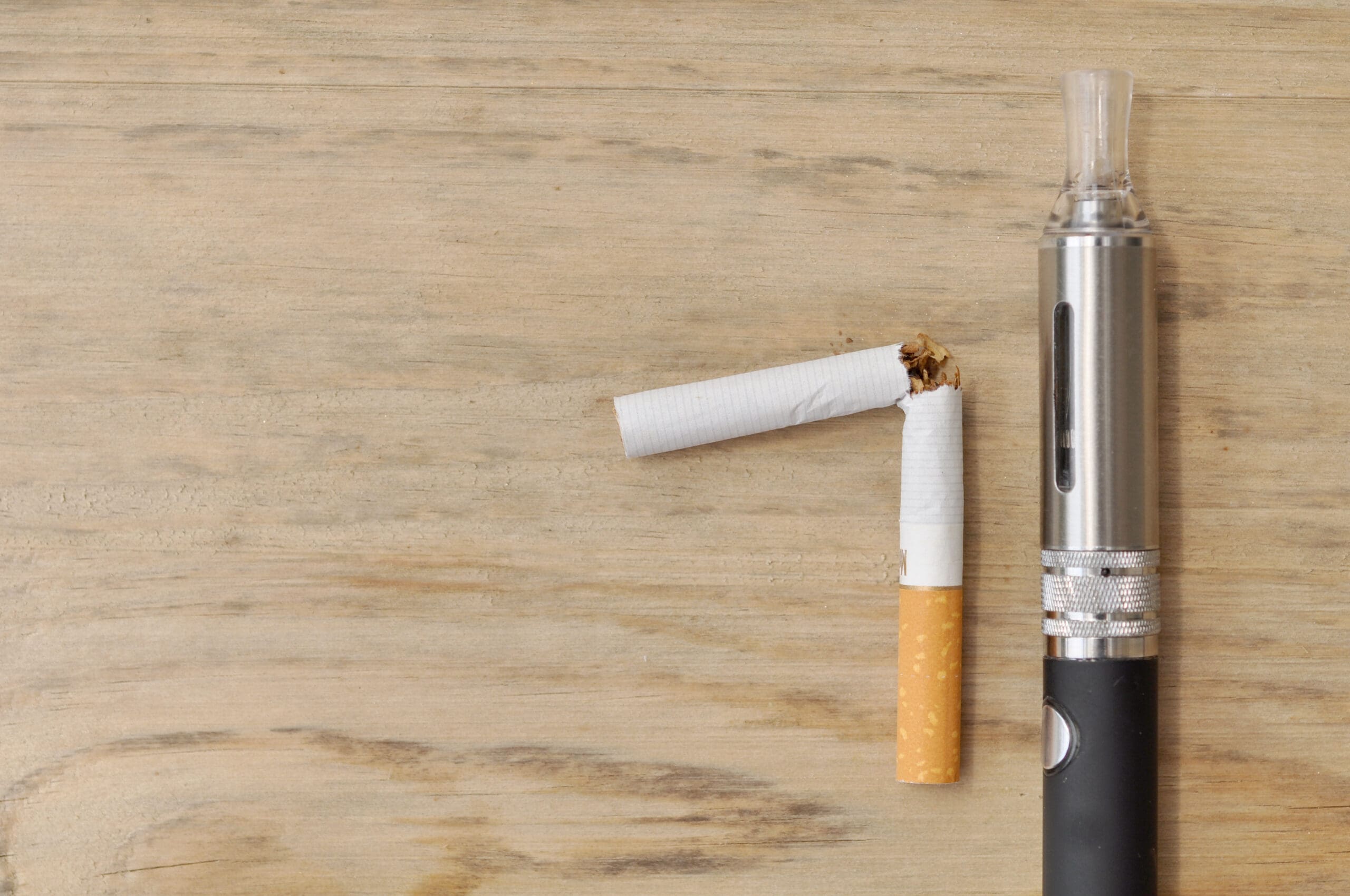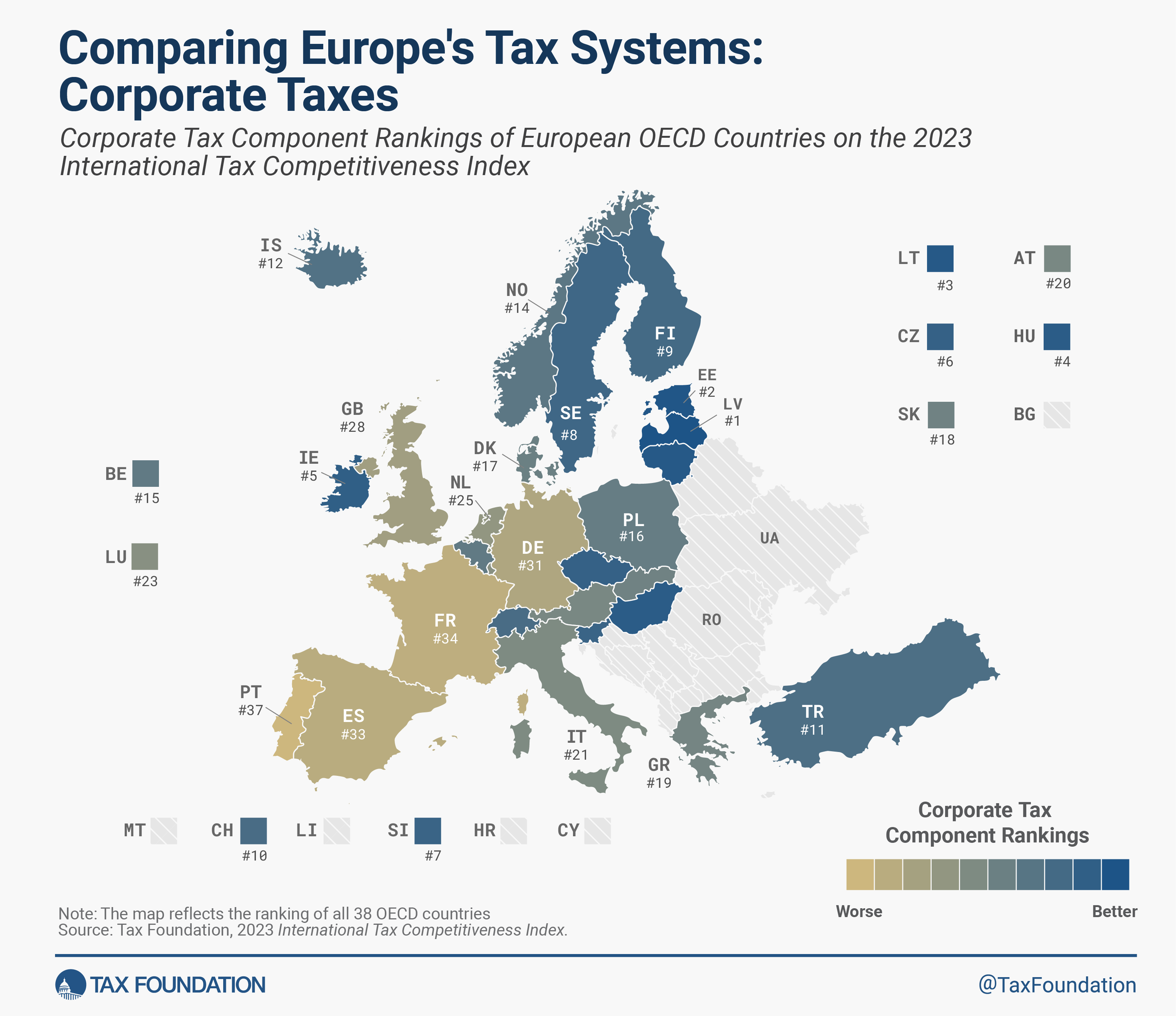How Should Alternative Tobacco Products Be Taxed?
Key Findings
- New alternative nicotine products offer less harmful methods of consuming nicotine. Switching consumption from combustible cigarettes to the products saves lives.
- To incentivize switching, safer nicotine products should receive a preferential tax rate compared to combustible cigarettes.
- Despite conclusive scientific evidence, many Americans believe nicotine is a carcinogen when it is not. Tax rates based on nicotine content should be avoided.
- An appropriate tax structure for alternative nicotine products is a specific tax per milliliter for vaping products and by weight for heated tobacco and modern oral products.
- Reduced rates should be given to products that are less harmful, substitutes for combustible cigarettes, more difficult to mass consume, and not addictive.
- Using evidence available at the time of this publication, four categories of tax rate reductions for less harmful alternative tobacco products are:
- 50 percent reduction: very low nicotine cigarettes, loose tobacco
- 75 percent reduction: heated tobacco products, moist oral tobacco
- 90 percent reduction: vapor and modern oral (snuff, snus, and pouches)
- 100 percent reduction: nicotine replacement therapies (gums, lozenges, and patches)
Introduction
The nicotine market in the United States is transforming. The innovation and development of alternative nicotine consumption products represents a massive change from a market historically dominated by cigarettes. Alternative tobacco products allow users to consume nicotine with only a fraction of the risk present in combustible cigarettes. With appropriate tax and regulatory policy, these products have the potential to save millions of lives each year.
Smoking rates have been on a steady decline for the past half-century. In 1965, more than 40 percent of adults smoked.[1] By 2005, that rate fell by almost half, to 20.9 percent, and by 2021, the rate fell by nearly half again, as only 11.5 percent of U.S. adults smoked.[2]
Accompanying this trend, and helping to facilitate cigarette consumption decline, has been the development of alternative nicotine consumption products. Consumers have expressed a willingness to switch to less harmful forms of nicotine consumption. The major product developments occurred in three categories: e-cigarettes or vaping products, oral nicotine delivery, and heat-not-burn (HNB) or heated tobacco products (HTPs).
Vapor products hit U.S. markets in 2007. While e-cigarettes and vaping devices started as niche products, sold in the relative obscurity of shopping mall kiosks and small online retailers, vapor products are now commonly sold at gas stations, convenience stores, and even dedicated brick-and-mortar vapor stores.
Vaping quickly grew in the United States. By 2019, vapor products made up close to 5 percent of the total tobacco market.[3] In 2022, with estimated sales of more than $7 billion, the e-cigarette and vaping market is now 10 percent the size of the market for combustible cigarettes.[4] A Gallup poll fielded in 2022 found that 13 percent of American adults under the age of 50 had used e-cigarettes or vaped in the past week.[5]
Like vapor products, modern oral nicotine products offer smokers a less harmful alternative to combustible cigarettes. Snus products were the first tobacco products to be granted a modified risk order by the U.S. Food and Drug Administration (FDA).[6] Snus is not a new product like vapor products; it has a rather long history in Scandinavia, where it is more widely consumed than cigarettes. It is relatively new to the U.S., however. Only about 2.1 percent of adults in 2021 reported using any kind of smokeless tobacco, including chewing tobacco, snuff, dip, and snus.[7]
Tobacco-free nicotine pouches are also a growing category.[8] These pouches are similar to chewing tobacco and snus, but do not include tobacco. Instead, the product is a chewing gum-based pouch that has nicotine added.
Finally, heated tobacco products offer a unique form of nicotine consumption that is less dangerous than combustible cigarettes. HTPs or HNB products heat tobacco but prevent it from combusting. By heating but not burning the tobacco, HTPs allow users to consume nicotine contained in tobacco, but with fewer harmful chemicals than traditional combustible cigarettes. The HTP IQOS brand received modified risk tobacco product (MRTP) status from the FDA in 2020 and sales are expected to begin (again) in early 2024.[9]
As nicotine products become more popular, the debate intensifies over their public health implications. While there is a near consensus that these products are remarkably safer to consume than combustible cigarettes, the products are simply too new to have completed long-term evaluations of their effect on users’ health.
Some reports have suggested that vaping may cause damage to consumers’ lungs. Select lower-quality products were brought to market, later failing basic regulatory standards, that harmed users’ health. Lawmakers and health professionals have also voiced concerns that vapor products could serve as a gateway to traditional tobacco use, particularly among minors.
Many others view these new nicotine products as a viable smoking cessation method, a net benefit for public health. Several studies suggest that nicotine products can play a significant role in harm reduction by reducing the consumption of traditional cigarettes.[10]
This paper discusses the rationale for taxing nicotine products and will provide a framework for incorporating risk and harm reduction into tax policy.
The following are definitions for terms used throughout the paper:
- Electric nicotine delivery system, e-cigarette, or vapor product: Products consisting of a battery, atomizer, and nicotine cartridge; they generally come in two varieties: open systems and closed systems
- Heated tobacco product: Creates a vapor rather than smoke as the tobacco is heated, but not combusted
- Snus: A pasteurized moist powder tobacco originating from Sweden; used like American dipping tobacco but do not require spitting
- Moist snuff or dip: Cut tobacco that is placed in the mouth
- Dry snuff: Loose, finely cut or powdered dry tobacco that is typically sniffed through the nostrils
- Nicotine pouches: An oral gum pouch containing nicotine
- Loose tobacco or roll your own (RYO): Loose, naturally grown tobacco that can be used for consumption (rolled into cigarettes, stuffed into pipes, etc.)
- Nicotine replacement therapies (NRTs): Gums, patches, sprays, or inhalers that provide nicotine, often purchased in an effort to help a user quit smoking
Harm Reduction
To better understand the trade-offs involved in nicotine tax policy design, it is crucial to introduce the concept of harm reduction. Harm reduction emphasizes the practicality of reducing the harm associated with certain goods rather than attempting to eliminate it entirely through bans or excessively high taxes. This approach represents a departure from the traditional thinking that has dominated public health efforts to promote cessation.
The FDA recognizes harm reduction through its classifications of premarket tobacco product application (PMTA) and modified risk tobacco products. Under these classifications, certain tobacco and nicotine products can be designated as less harmful compared to others. For instance, the first-ever MRTP order was granted to Swedish-style snus products, allowing the manufacturer to claim that the use of these products lowers consumers’ risks in comparison to cigarettes.
A public policy strategy focused on harm reduction is important for several reasons. According to the Centers for Disease Control and Prevention (CDC), there are approximately 33 million smokers in the United States, with around 68 percent of them expressing interest in quitting.[11] However, the success rate of quitting is currently about 7 percent (and only slightly higher for younger smokers at around 10 percent). The addictive nature of nicotine makes quitting extremely challenging.
One approach to help the 22.7 million Americans who want to quit smoking is to provide them with less harmful alternatives to cigarettes for use as cessation tools. The nicotine products discussed in this paper can play a vital role in fulfilling this objective.
Protecting access to harm-reducing products is closely linked to the design of excise taxes, as many of these products serve as substitutes for combustible cigarettes. The deterrent effect of cigarette excise taxes also increases when more affordable substitutes are readily available.
Taxing nicotine products proportionately to their harm is a logical strategy. Some states have already implemented provisions in their tax codes that reduce taxes by half when a product receives an MRTP order from the FDA.
Background: Why Tax Nicotine?
Excise taxes are targeted taxes, generally levied on specific products or activities in addition to broad, general sales taxes. The targeted, narrow tax base needs a justification to warrant a special tax.
Excise taxes are sometimes referred to as “sin taxes” because they are often levied on products whose consumption is considered socially undesirable. Targets for selective excise taxes include products that are unhealthy for the consumer, create costs for others that are not reflected in the market price of the product (referred to as negative externalities), or generate burdens on public expenditures (a class of negative externalities which we have termed “governalities”).
Combustible cigarettes check all the boxes for the “sin tax.” Cigarettes are harmful to smokers, second-hand smoke creates harm for bystanders, and low-income smokers absorb a disproportionate amount of public health expenditures. Not surprisingly, tobacco is the most highly taxed consumer product in the United States.[12]
It may be easy to conclude that nicotine and cigarettes are one and the same. Nicotine is, after all, the addictive chemical within tobacco and cigarettes that attracts smokers. However, nicotine itself is not a carcinogen. The other chemicals in cigarettes and tobacco are what cause cancer.
Research supported by the FDA, Cancer Research UK, Health Canada, and the World Health Organization repeatedly show that nicotine is not the cause of cancer.[13] However, a growing percentage of surveyed Americans—more than 50 percent in 2019—reported that they believed nicotine was the substance in cigarettes that caused cancer.[14] Worse, more than three quarters of physicians agreed that nicotine directly contributes to cancer.[15]
Nicotine misconceptions remain some of the greatest and most persistent in public health discussions. Nicotine consumption, outside of combustible cigarettes, carries substantially less harm than smoking. This distinction is essential for creating public policy related to new methods of nicotine consumption.
To the extent that legislators do choose to tax nicotine products, they should design a principled excise regime. Legislators should incorporate harm reduction into the tax design to focus on raising revenue in a simple, neutral, transparent, and stable manner. Levying taxes based on these principles limits the adverse effects on the economy and individual consumers.
How to Tax Alternative Nicotine Products
Alternative nicotine products present a challenging case for tax policy. Historically, for excise taxes that target harm-generating products, the best tax base targets the harm-causing element. Targeting the harm-causing element allows market participants to internalize the external harm into their decision-making. Taxes on hard alcohol increase based on alcohol content or proof per gallon. Similarly, a tax placed on carbon emissions can price in external damages from pollution and climate change into energy consumption and production decisions.
Alternative tobacco products don’t create similar kinds of external costs, nor is there a clear ingredient in these products that can be targeted with an excise tax. As mentioned above, nicotine does not directly create external harm. Without a target ingredient to create the tax base, tax policy will be forced to use a broader base determined by consumption, likely with several different tax rates based on product and category.
In this scenario, quantity-based specific taxes are also better than ad valorem taxes at aligning the tax base to the tax’s purpose. For nicotine products, the number of cigarettes smoked or the amount of vapor inhaled has a much clearer connection to any harm caused by this consumption than the retail sales price of the products. Specific taxation is often simpler because the tax can be calculated based on weight, volume, or amount instead of an estimated value.
Simple, direct taxes work best as the tax base for alternative tobacco products. A weight-based tax for oral nicotine and heated tobacco products would be most effective. Similarly, vaping products can be taxed by milliliter of vaping solution. Low (or no) nicotine cigarettes sold in stick form (identical to traditional combustible cigarettes) can be taxed by the pack like traditional cigarettes. And any products sold in loose weight (like loose tobacco), can be taxed by weight. These structures capture the harmful behavior and keep the tax neutral.
Table 1. Proposed Tax Structure for Alternative Nicotine Products| Product | Tax Type |
|---|---|
| VLN Cigarettes | Specific by pack of 20 cigarettes |
| Vapor Products | Specific per milliliter |
| Heated Tobacco | Specific per ounce |
| Nicotine Pouches | Specific per ounce |
| Snus | Specific per ounce |
Tax Rates for Alternative Tobacco Products
Tax rates on alternative nicotine and tobacco products should create price differentials between less harmful products and combustible cigarettes. From a public health standpoint, the rationale for taxing alternative nicotine products is weak. More research on the potential harm-reduction qualities of these newer products is needed, but the current scientific consensus is that vapor products, modern oral nicotine products, and HTPs are less harmful than traditional combustible tobacco products. For example, Public Health England, an agency of the English Ministry for Health, concluded that vapor products are 95 percent less harmful than cigarettes.[16]
A broad tax structure for alternative tobacco products would create tax (and price) differentials based on a continuum of risk. We propose a reduced tax rate corresponding to each alternative tobacco product’s risk profile, anchored to the existing tax rate for combustible cigarettes. In an ideal scenario, each product would have scientifically agreed-upon, precisely estimated, quantifiable harm and risk measures. Those measures could be compared to similar estimates for cigarettes to determine a measure of relative harm and risk.
If we could confidently say that snus products were 98 percent less harmful than cigarettes, a tax on snus that was 98 percent less than the tax rate on cigarettes would both capture the relative risk and harm of the product, while facilitating a market price differential that would incentivize consumers to choose snus consumption over cigarette consumption.
Unfortunately, such scientific precision and consensus are realistically impossible. Instead of having precise estimates and differential tax rates for each individual product, a categorical approach still allows differential tax rates and facilitates a range of relative risk estimates for products.
We establish four categories of reduced-harm products. Products in each category would have a tax rate reduction compared to combustible cigarettes. The tax rate for Category 1, the most harmful of the reduced-harm products, would be 50 percent of the rate on cigarettes. Products in Category 2—less harmful than products in Category 1—would be 25 percent of the tax rate on cigarettes (a 75 percent reduction). Products in Category 3 would have a tax rate of 10 percent of the rate on cigarettes. Finally, products in Category 4 would have no tax.
Any product can be placed into a specific category based on four criteria.
1. Harm caused (+)
The greater the harm caused by the product, the greater its tax rate. The less harmful, the lower the tax rate.
We consider products on a continuum of risk, where combustible cigarettes are the most dangerous and no tobacco consumption is the safest. Combustible products are more harmful than products that are simply heated or are non-combustible. Consuming nicotine from inhaling products through the lungs is more dangerous than oral consumption. Transdermal consumption is less dangerous than all other methods currently on the market.
2. Substitutability with combustible cigarettes (-)
The more easily a product functions as a substitute for combustible cigarettes, the lower its tax rate will be. Transitioning from combustible cigarettes to any other form of nicotine consumption reduces harm. The degree to which a product is a substitute for combustible cigarettes is quantified by empirical studies by calculating the cross-price elasticity. The cross-price elasticity identifies how much consumption of a product changes (e.g., vaping products) when the price of another product (e.g., cigarettes) changes. The table below identifies how much consumption of various non-cigarette products changes when the price of cigarettes changes.
3. Ease of (mass) consumption (+)
How easy is it for a user to consume mass quantities of a (potentially harmful) product? The more easily a consumer can consume large quantities of a harmful product, the greater the tax rate for that product will be.
4. Addictiveness (+)
Nicotine is addictive, so any products containing significant amounts of nicotine will be addictive. If a product can show empirical evidence that it is not addictive or if it contains a nicotine content below a certain “addictive threshold,” then it receives beneficial tax treatment.
Table 2. Substitutability of Various Products with Cigarettes| Product | Percentage Change in Consumption Caused by a 10 Percent Increase in Cigarette Prices |
|---|---|
| Cigars | -6.5% |
| Little Cigars | 8.6% |
| Loose Tobacco | 15.7% |
| Chewing Tobacco* | -5.7% |
| Snus | -1.1% |
| E-Cigarettes | 12.0% |
| NRTs: Gum* | 2.7% |
| NRT: Patch* | 4.0% |
| NRT: Lozenge | 6.5% |
| Notes: Cross-price elasticity with cigarette prices at the market-level for sales at food, drug, and mass merchandise stores and convenience stores. | |
| Sources: Jidong Huang et al., “A comprehensive examination of own-and cross-price elasticities of tobacco and nicotine replacement products in the US,” Preventive medicine 117 (2018): 107-114; Mohammed Jawad et al., “Price elasticity of demand of non-cigarette tobacco products: a systematic review and meta-analysis,” Tobacco control 27:6 (2018): 689-695. | |
| *The confidence interval of the estimated effect spans zero; we cannot reject the null hypothesis that these products are not substitutes. | |
Assignment of Alternative Tobacco Products to Harm Reduction Categories
Category 1: 50 percent of the tax rate of combustible cigarettes (50 percent tax rate reduction)
- VLN cigarettes: Just as harmful as combustible cigarettes, insufficient evidence of substitutability; easy to mass consume; possibly not addictive
- Loose tobacco: Just as harmful as combustible cigarettes, insufficient evidence to date of substitutability; more difficult to mass consume; addictive
Category 2: 25 percent of the tax rate of combustible cigarettes (75 percent tax rate reduction)
- HTPs: less harm, insufficient evidence to date of substitutability; easy to mass consume; addicting
- Moist tobacco: less harm, insufficient evidence to date of substitutability; easy to mass consume; addicting
Category 3: 10 percent of the tax rate of combustible cigarettes (90 percent tax rate reduction)
- Vapor: less harm, strong substitute; easy to consume; addicting
- Modern oral tobacco (including snuff, snus, and pouches): much less harm, limited evidence of substitutability; easy to consume; addicting
Category 4: 0 percent of the tax rate of combustible cigarettes (100 percent tax rate reduction)
- NRT patches, gums, and lozenges: little to no harm, mixed evidence of substitutability; easy to consume; addicting, but there is little evidence of mass addiction from these products
Conclusion
New alternative tobacco products have emerged as a significantly less harmful means of consuming nicotine. These products include heat-not-burn tobacco products; vaping; and nicotine pouches, patches, and gums. Many of these products are direct substitutes for smoking, representing incredible opportunities for harm reduction. However, tax and regulatory restrictions on these products are inconsistent.
In this paper, we presented a categorical approach that would create reduced tax rates for reduced-harm products. Less harmful products receive a tax rate that is 50-100 percent less than the tax rate applied to combustible cigarettes. Creating tax rates as a percentage of cigarette tax rates helps ensure price differentials that incentivize consumers to switch, while being relatively easy for legislators to adopt at any level of government.
Products are assigned to reduced risk categories based on the degree of harm the product causes, how easily the product acts as a substitute for combustible cigarettes, how easily the product can be (mass) consumed, and whether the product is addictive. The more the product is safe, acts as a cigarette substitute, is slowly consumed, and is less addictive, the lower the product’s tax rate will be.
Creating public policy around new and innovative products can be challenging. However, the potential for alternative tobacco products to save lives is clear and well established. The framework described in this paper uses a scientific approach to tax strategy that will both reduce harm and create a reliable revenue stream for public expenditures.
Stay informed on the tax policies impacting you.
Subscribe to get insights from our trusted experts delivered straight to your inbox.
Subscribe
References
[1] American Lung Association, “Overall Tobacco Trends,”
[2] Centers for Disease Control and Prevention, “Current Cigarette Smoking Among Adults in the United States,” May 4, 2023,
[3] Bonnie Herzog, “Wall Street Tobacco Industry Update,” Wells Fargo, Feb. 11, 2019,
[4] Grand View Research, “E-cigarette And Vape Market Size, Share & Trends Analysis Report By Product (Modular Devices, Rechargeable), By Distribution Channel (Online, Retail), By Region (APAC, North America), And Segment Forecasts, 2023 – 2030,” Fatma Romeh M. Ali et al., “Trends in Annual Sales and Pack Price of Cigarettes in the US, 2015-2021,” JAMA Network Open (June 2022),
[5] Justin McCarthy, “What Percentage of Americans Vape?” Gallup, Aug. 17, 2022.
[6] U.S. Food & Drug Administration, “FDA grants first-ever modified risk orders to eight smokeless tobacco products,” Oct. 22, 2019,
[7] Centers for Disease Control and Prevention, “Smokeless Tobacco Product Use in the United States,” May 4, 2023,
[8] Colm Fulton, “Swedish Match profits boosted by sales of tobacco-free pouches,” Reuters, Oct. 25, 2019,
[9] IQOS is sold globally and entered the U.S. market in 2019 with sales in, Virginia, North Carolina, and South Carolina. Sales stopped in November 2021 due to a patent lawsuit but are expected to begin within the next year. For more information, see Lorien Abroms et al., “Anticipating IQOS market expansion in the United States,” Tobacco Prevention & Cessation 8 (2022),
[10] Joel L. Nitzkin, “The Case in Favor of E-Cigarettes for Tobacco Harm Reduction,” International Journal of Environmental Research and Public Health 11:6 (June 2014), and Pasquale Caponnetto, Davide Campagna, Fabio Cibella, Jaymin B. Morjaria, Massimo Caruso, Cristina Russo, and Riccardo Polosa, “Efficiency and Safety of an electronic cigarette (ECLAT) as Tobacco Cigarettes Substitute: A Prospective 12-Month Randomized Control Design Study,” PLOS One (Jun. 24, 2013),
[11] Centers for Disease Control and Prevention, “Smoking Cessation: Fast Facts,” Mar. 21, 2022,
[12] Adam Hoffer, “Compare Tobacco Tax Data in Your State,” Tax Foundation, May 24, 2023,
[13] Brian Erkkila, “Nicotine Harm and Misconceptions,” Presentation at 2023 TMA Conference,
[14] Ibid.
[15] Michelle T. Bover Manderski et al., “Persistent Misperceptions about Nicotine among US Physicians: Results from a Randomized Survey Experiment,” International Journal of Environmental Research and Public Health (2021),
[16] Public Health England, “E-cigarettes around 95% less harmful than tobacco estimates landmark review,” Aug. 19, 2015,
Share






